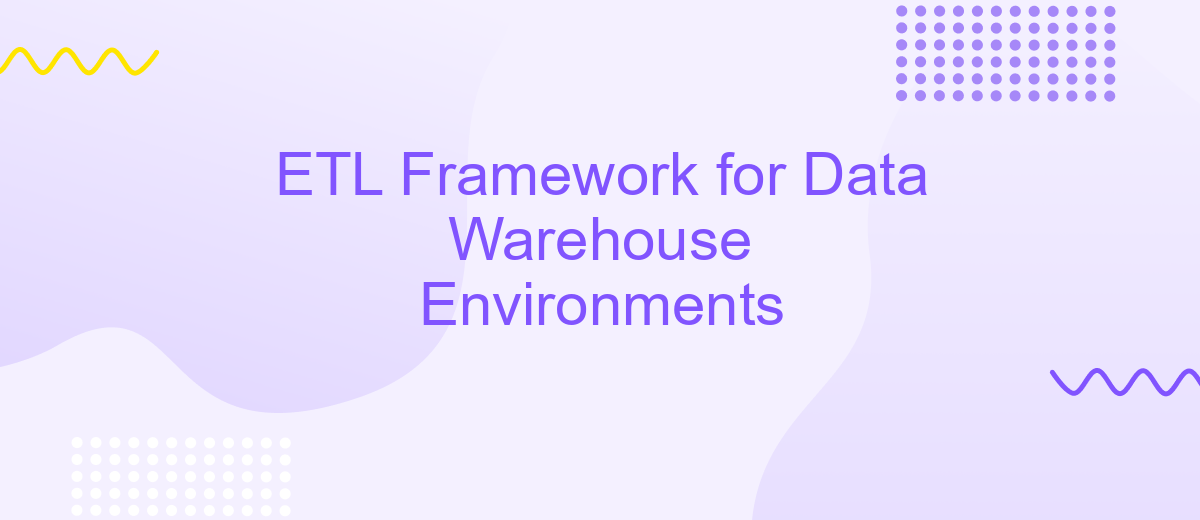ETL Framework for Data Warehouse Environments
In today's data-driven world, efficient data management is crucial for business success. ETL (Extract, Transform, Load) frameworks play a pivotal role in data warehousing environments by ensuring seamless data integration, transformation, and loading processes. This article explores the essential components, best practices, and benefits of implementing an ETL framework to optimize data workflows and enhance decision-making capabilities.
Introduction
ETL (Extract, Transform, Load) frameworks are essential components in the architecture of data warehouses, ensuring the seamless integration, transformation, and loading of data from various sources into a centralized repository. These frameworks facilitate the efficient handling of large volumes of data, enabling organizations to derive meaningful insights and make informed decisions. The importance of an effective ETL framework cannot be overstated, as it directly impacts the performance and reliability of the data warehouse environment.
- Extraction: Gathering data from diverse sources such as databases, APIs, and flat files.
- Transformation: Converting data into a suitable format for analysis, including data cleaning and enrichment.
- Loading: Inserting the transformed data into the data warehouse for storage and retrieval.
In the context of modern data integration, services like ApiX-Drive play a crucial role by simplifying the setup of integrations and automating data workflows. ApiX-Drive enables seamless connectivity between various applications and data sources, ensuring that data is consistently and accurately transferred to the data warehouse. This not only enhances operational efficiency but also ensures data integrity and reliability, making it an invaluable tool for organizations aiming to optimize their ETL processes.
ETL Framework Overview

ETL (Extract, Transform, Load) frameworks are essential for managing and processing large volumes of data in data warehouse environments. These frameworks automate the process of extracting data from various sources, transforming it into a suitable format, and loading it into a data warehouse for analysis and reporting. This automation ensures data consistency, accuracy, and efficiency, which are critical for businesses relying on data-driven decision-making.
One of the key aspects of an effective ETL framework is its ability to integrate seamlessly with different data sources and platforms. Tools like ApiX-Drive can significantly enhance this capability by providing a user-friendly interface for setting up integrations without the need for extensive coding. ApiX-Drive supports a wide range of applications and services, enabling businesses to streamline their data workflows and ensure real-time data synchronization. This not only reduces the time and effort required for manual data handling but also minimizes the risk of errors, ensuring that the data in the warehouse is always up-to-date and reliable.
ETL Process Components

The ETL process is fundamental to data warehousing, involving three primary components: Extraction, Transformation, and Loading. Each component plays a crucial role in ensuring data is accurately and efficiently transferred from source systems to the data warehouse.
- Extraction: This step involves retrieving data from various source systems, such as databases, APIs, or flat files. Tools like ApiX-Drive can facilitate seamless integration and data extraction from multiple sources, ensuring a consistent and reliable data flow.
- Transformation: Once the data is extracted, it is transformed to fit the required format and structure of the data warehouse. This may include data cleaning, normalization, aggregation, and applying business rules to ensure data quality and consistency.
- Loading: The final step involves loading the transformed data into the data warehouse. This can be done in batch mode or real-time, depending on the requirements and the architecture of the data warehouse.
By utilizing a reliable ETL framework, organizations can ensure that their data is accurate, timely, and ready for analysis. Tools like ApiX-Drive streamline the extraction process, making it easier to integrate multiple data sources and maintain data integrity throughout the ETL process.
Benefits and Challenges of using an ETL Framework

Implementing an ETL framework in data warehouse environments offers numerous benefits, streamlining data integration and improving overall efficiency. An ETL framework automates data extraction, transformation, and loading processes, ensuring data consistency and quality. This automation reduces manual intervention, minimizing errors and freeing up valuable resources for other tasks.
However, using an ETL framework also presents certain challenges. Initial setup and configuration can be complex, requiring specialized knowledge and skills. Additionally, maintaining and updating the framework to accommodate changing data sources and business requirements can be resource-intensive.
- Enhanced data quality and consistency
- Reduced manual intervention and errors
- Improved efficiency and resource allocation
- Scalability to handle growing data volumes
- Streamlined integration with tools like ApiX-Drive
Despite these challenges, the benefits of using an ETL framework often outweigh the drawbacks. Tools like ApiX-Drive can simplify the integration process, allowing businesses to connect various data sources seamlessly. By leveraging an ETL framework, organizations can ensure their data warehouse environments are robust, reliable, and capable of supporting data-driven decision-making.
Conclusion
In conclusion, implementing an ETL framework is crucial for optimizing data warehouse environments. By streamlining the processes of extracting, transforming, and loading data, organizations can ensure higher data quality, improved performance, and enhanced decision-making capabilities. The right ETL framework not only automates data workflows but also provides scalability and flexibility to adapt to evolving business needs.
Moreover, integrating ETL frameworks with services like ApiX-Drive can further enhance efficiency. ApiX-Drive simplifies the integration process, allowing seamless data transfer between various applications and systems. This reduces manual intervention and minimizes the risk of errors. Ultimately, leveraging robust ETL frameworks and integration services can significantly contribute to a more agile and responsive data infrastructure, empowering businesses to harness the full potential of their data assets.
FAQ
What is an ETL framework, and why is it important for data warehouse environments?
How do you handle data quality issues in an ETL process?
What are the key components of an ETL framework?
How can automation improve the ETL process?
What are the common challenges faced in implementing an ETL framework?
Time is the most valuable resource in today's business realities. By eliminating the routine from work processes, you will get more opportunities to implement the most daring plans and ideas. Choose – you can continue to waste time, money and nerves on inefficient solutions, or you can use ApiX-Drive, automating work processes and achieving results with minimal investment of money, effort and human resources.

